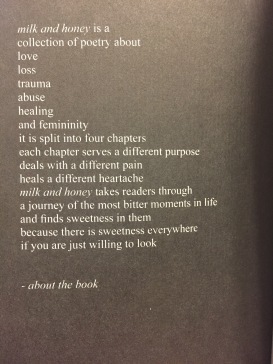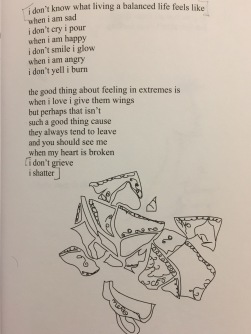milk and honey by Rupi Kaur is a collection of poetry that explores different types of pain and how they manifest within people. These poems challenge traditional poetry (for example rhyme schemes, meter, et cetera) and take on the form of prose or free-verse poetry.
This free-verse form makes the poems a bit more accessible. Often, readers will avoid poetry because it is hard to read. However, milk and honey isn’t just for avid poetry readers. It doesn’t make your head spin with intricate language that needs to be deciphered.
This book deals with emotions that every reader can relate to in some way or another. Kaur offers multiple genres that these poems can fall into on the “about the book” page:

For the most part, milk and honey falls into the genre of surviving life. As Kaur explains on the back cover, this book is
the journey of surviving through poetry… this is my heart in your hands,
I think that perfectly sums up this collection of poems as a whole. Everyone goes through the journey of survival, which is why these poems are applicable to everyone. Everything that Kaur says her poetry is about is experienced in everyone’s life I think (with, perhaps, the exception of femininity). Everyone has hurt, loved, been broken, and healed. It’s a part of the journey of survival. The best part of poetry and of literature, in general, is that it has the power to heal and serve as a band-aid for life’s obstacles. It is a companion on the journey of survival, the long and winding trek of life. Kaur’s poetry is applicable to everyone, accessible
Kaur’s poetry is applicable to everyone, accessible by everyone. It is vague and ambiguous, so readers can derive their own meaning from their words. Kaur had her own experiences that inspired the writing of these poems, but everyone who reads any one of these poems finds their own pain, their own heartache, or maybe even their own healing in it.
There are many stylistic features that allow for the reader to respond to the pain and the journey of survival. Kaur often uses the second person point of view, which allows for the reader to place themselves within the piece. From the very first poem, “you” is used.
how is it so easy for you
to be kind to people he asked
milk and honey dripped
from my lips as i answered
cause people have not
been kind to me
Right off the bat we are placed into the poem, and we think, “Why yes, people have not been kind to me. I am really nice to people.” We relate so easily even though this was written from Kaur’s experiences. That’s one of the benefits of the features that work it this genre: easily accessible. The reader becomes the one telling the narrative.
Another stylistic feature is the images that correspond to certain poems allow for the manipulation of the reader and further coerces them to access their past experiences and to apply these poems to their own pain.

Clearly, from my own annotations I was able to access my own memories and pain when I read this poem. Of course, the poem itself allowed me to do that, but the illustration further ignites these emotions. It makes the reader take a moment and consider what the illustration means in relation to the poem.
Other trends within this poem are the different forms. I noted the repetitive form and the syllogistic progressive form. Milk and honey, or just honey, is used in multiple different poems. It resurfaces many times. Also, Kaur often uses tags at the end of a poem to sum up the poem or to make a point in a manner that really sticks with the reader. It’s almost as if it’s a title at the end of a poem. For example, one poem ends with
-the art of being empty (33)
Finally, the syllogistic progressive form can be found within the use of the four different chapters– the hurting, the loving, the breaking, and the healing. These four chapters unfold the progression of the Kaur’s life. Referring back to the back cover, Kaur says,
this is the blood sweat tears
of twenty-one years
Throughout the four chapters, we travel through Kaur’s childhood, her relationships, her heartbreak, her finding her own happiness, and her healing. One of the last poems makes one of the arguments that she consistently made throughout the book.
if you are not enough for yourself
you will never be enough
for someone else (197)
This was the main argument that I believe she was trying to make throughout all for chapters of the book: self-love must come first. Kaur’s traumas led up to this realization, and she leads us to the same epiphany by taking us through our own pain.
milk and honey was very successful in making the reader feel the pain that Kaur had felt intended any given poem, but also rehashing the reader’s own experiences and traumas. I think that’s what makes this a successful piece. It challenges the traditional genre poetry, and it uses elements that connect the writer/narrator, and the audience. It manipulates form and genre very well.
I like the idea of that Kaur makes poetry more accessible through her use of language. She uses poetry as a genre, as well as a form to create a unique structure to tell her personal story through. A you mentioned in your blog post, her poetry acts as a “Band-aid for life’s obstacles.” which is definitely true. The author use of form and genre does not only make the text more accessible and easier to understand for the unexperienced poetry reader, but the simplicity of the writing is also more impactful and powerful as well, which as you mentioned helps to create a successful piece
LikeLike
I have to say I am not a fan of the free-verse poetry style. It seems more like quotes to me. It is by no means bad, but maybe just not my cup of tea because it comes off as rambling positive or negative sentences and then the readers has to make sense of it all. Like a quote-puzzle in a way. Maybe if the genre she used was short stories I would have connected big time. But since it was free-verse poetry I had to become a submissive reader to the genre and try to understand the overall point Kaur is trying to get across.
LikeLike